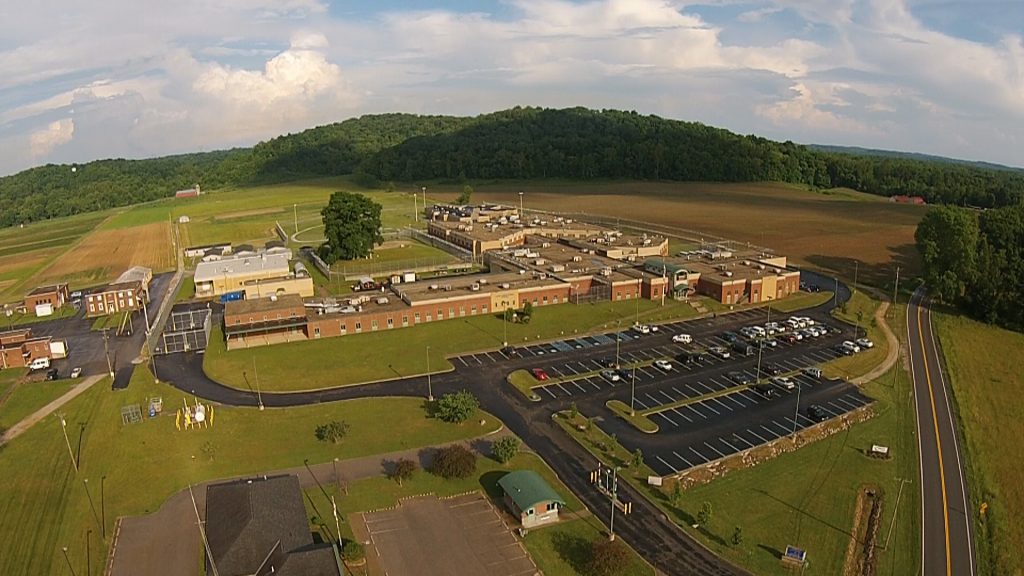Substance Abuse Treatment in Demand at Lakin Correctional Center

Lakin Correctional Facility in Mason County, West Virginia
Photographed by Mike Youngren; courtesy of West Virginia Division of Corrections and Rehabilitation
Three days a week, Lakin Correctional Center Program Facilitator Samantha Rollins puts aside her responsibilities overseeing the prison’s other inmate programs to focus on administering classes on Cognitive-Behavioral Interventions for Substance Abuse (CBISA). She offers four classes per day, with an average of 12 to 14 women in each class.
Rollins admits that she has a lot on her plate, but she manages to fill her schedule as best she can to accommodate Lakin’s need. On her waiting list, however, are the names of around 60 more women waiting to receive treatment for substance use.
“The waiting list is down a lot,” Rollins said. “It’s down to two pages, which is really phenomenal.”
While Rollins is excited by the progress Lakin has made to get women the help they need, the the need for substance use treatment still outpaces the resources available at the Correctional Center.
From 2004 to 2018, drug crimes in West Virginia increased by 220 percent according to the West Virginia Division of Corrections (DCR) annual report. The DCR also reported that a little over 25 percent of those admitted to the state’s regional jails in 2018 required detox due to substance use disorder. Only 1.43 percent required detox in 2013.
Since 2015, the state has invested around $11 million through justice reinvestment money to support programs that could reduce the incarceration rate and prevent recidivism. Most of these programs, like Recovery Point of Huntington, include some form of substance use disorder rehabilitation.
Inside the prison system as well, substance abuse treatment programs are an important part of programming.
Nationally, the Bureau of Justice Statistics reported that from 2007-2009, 69% of women in prison met the criteria for drug dependence or abuse. At Lakin Correctional Facility, West Virginia’s female prison, that would be about 390 of the 565 residents in 2019.
Paula Ray, a Case Manager at Lakin, says, “There’s a lot of people in the programs. A very small portion are not in any kind of drug class or program.” But the programs vary in terms of their intensity.
At Lakin, women may participate in the Residential Substance Abuse Treatment program; non-residential treatment in the Cognitive-Behavioral Interventions for Substance Abuse (CBISA) program or weekly meetings for Narcotics Anonymous and Alcoholics Anonymous.
Case Managers like Ray evaluate each woman based on her social, educational, psychological, criminal and drug use history to determine which program will best suit her.
“We look at anything that they’ve used within the last year before incarceration,” Ray said. “We want to know their use, how much they’ve used, if they had to keep using more to get more of an effect, and how their withdrawal symptoms were if they withdrew.”
Based on that evaluation, women are approved for the various programs.
According to the most recent data from communications director for the West Virginia Department of Military Affairs and Public Safety, Lawrence Messina, the facility’s RSAT program was running at capacity with 45 women in December of 2019.
This program, like CBISA, has a waiting list organized by parole date.
Treatment for substance use disorder is complex and often takes more than one attempt at rehabilitation. While there aren’t reliable statistics on how many times it takes to remain clean, Ray said, “It’s up to those in the programs to internalize the message they receive.”
Combatting substance use disorder is an important part of the state’s plan to reduce recidivism and decrease the incarcerated population. Between 2014 and 2017, the DCR reported that of the 588 people released with drug and narcotic offenses, 113 returned to the correctional system for the same crime.
By Joey White


